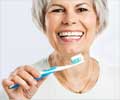February is being marked as the National Children's Dental Health Month and the focus is on preventing tooth decay
February is being marked as the National Children's Dental Health Month and the focus is on preventing tooth decay. Despite the widespread use of fluorides and school water fluoridation projects, preschoolers are developing cavities at an alarming rate. However, it must be pointed out that the problem begins much before the kid reaches the school stage.
Baby Bottle Tooth Decay affects more infants and two-year-olds these days than before. Also called as rampant caries, this syndrome is related to the amount of time that a infant is allowed to nuzzle on the milk bottle. What actually happens is that the milk is in contact with the teeth for a long time, sometimes all night. This is not an ideal scenario since the teeth have just begun erupting into the oral cavity or the mouth.Sasha is a cherubic and a smart looking 2-year-old girl until she opens her mouth. The black stumps of what are left of her teeth give her a fearful look. It is this disease, wherein almost all teeth except the lower front teeth are decayed that is called as the baby bottle tooth decay syndrome. Indeed, it leaves quite a lot of scars, physical and emotional as the kid enters early childhood. But following certain guidelines can help prevent this condition.
The American Academy of Pediatric Dentistry recommends that parents should monitor their kids' brushing habits until they are at least 7. Infants should be weaned away from the bottle from the age of 9 months and encouraged to drink from cups. This avoids the all-night long contact of milk with the teeth, which is a sure invitation to tooth-destroying bacteria. And get your child for regular dental check ups from the age of 1 year. That will sensitize them to the importance of tooth care from early on.











